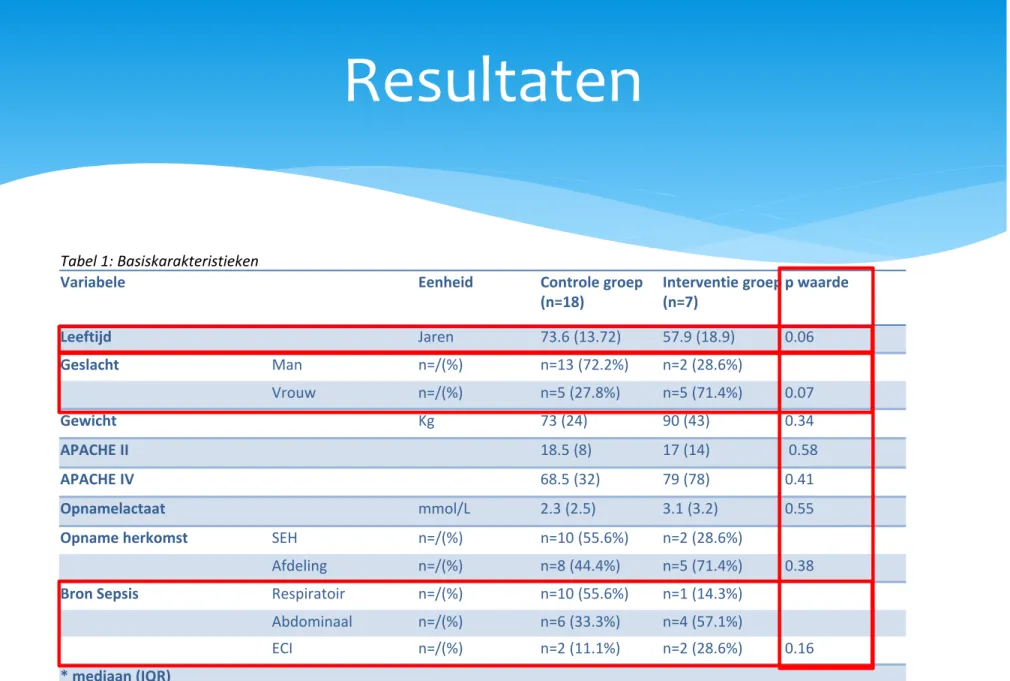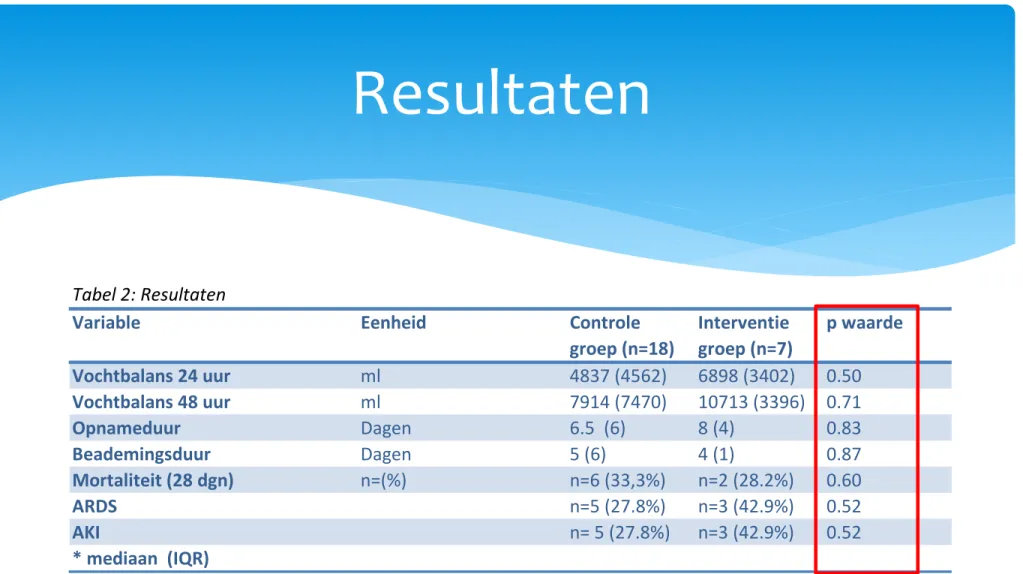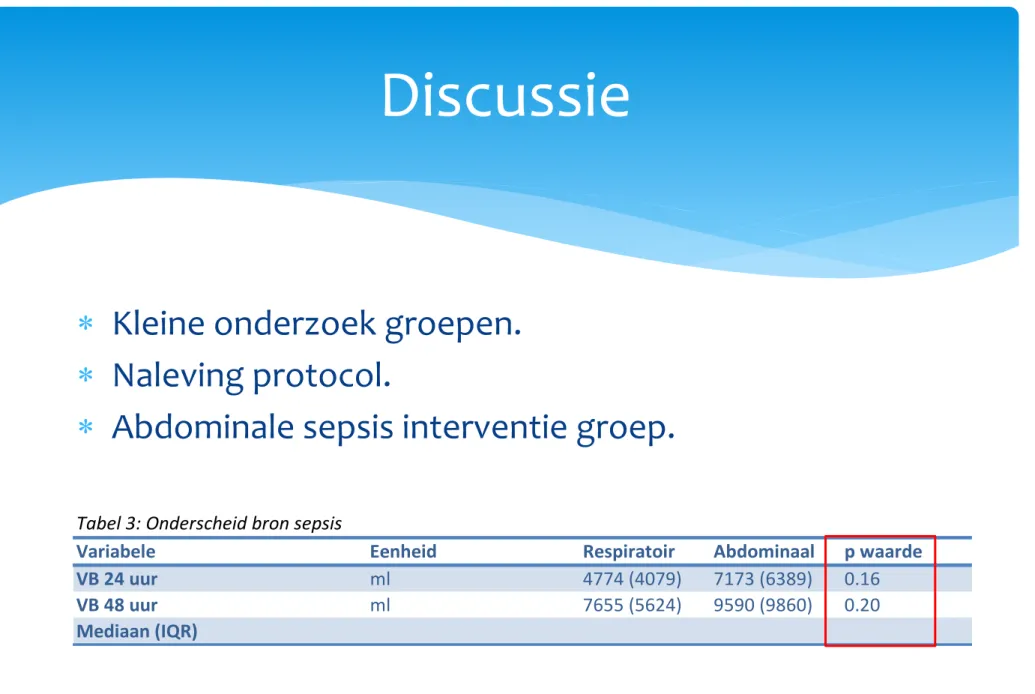De effecten van fluid
responsiveness bepalen bij
patiënten met ernstige sepsis
Inleiding
Aanleiding
Probleem‐, doel‐ en vraagstelling
Literatuur onderzoek
Praktijkonderzoek
Conclusies en aanbevelingen
Inhoud
Het Waterlandziekenhuis (WLZ) te Purmerend
Algemeen ziekenhuis, 275 bedden.
Intensive Care (IC), 7 bedden, 6 beademingen.
Niveau 1 IC
Geen eenduidig beleid rondom vochtresuscitatie.
Geen protocol aanwezig
Vochtbalans positief
Er is geen eenduidig beleid omtrent
vloeistofresuscitatie bij patiënten met ernstige sepsis,
Wat resulteert in een positieve vochtbalans.
Inzichtelijk krijgen of de vochtbalans 24 en 48 uur na
vaststellen diagnose ernstige sepsis minder positief is
wanneer fluid responsiveness bepaald wordt.
Leidt het bepalen van fluid responsiveness tot een
lagere vochtbalans 24 en 48 uur na het vaststellen van
de diagnose ernstige sepsis?
Literatuurstudie
Literatuurstudie
Literatuurstudie
2213 patiënten, 311 ziekenhuizen, 46 landen.
Data collectie voorjaar 2013
Publicatie resultaten september 2015
Literatuurstudie
Verbeteren Cardiac Output (CO).
Verbeteren van weefselperfusie.
Verhogen van zuurstofaanbod (DO
2) weefsels.
1: Klinische probleem oplossen door CO te verbeteren?
PLR test
1
Scholing geven
Uitleg intensivisten
Flowchart
PLR implementeren
Verantwoordelijkheid arts.
FC = 500cc Kristalloïden, druk
Klinisch probleem?
2 ≥ SIRS criteria
Vermoeden / bewezen infectie Hypotensie ≥ 18 jaar 2014 Aantal patiënten (n = 24) 2015 Aantal patiënten (n = 12) Exclusie Opname <2 dgn (n = 5) Overplaatsing (n – 1) Exclusie Opname < 2 dgn (n = 3) Geen PiCCO (n = 2) Inclusie 2014 (n = 18) Inclusie 2015 (n = 7)
Resultaten
Tabel 1: Basiskarakteristieken
Variabele Eenheid Controle groep (n=18) Interventie groep (n=7) p waarde Leeftijd Jaren 73.6 (13.72) 57.9 (18.9) 0.06 Geslacht Man n=/(%) n=13 (72.2%) n=2 (28.6%) Vrouw n=/(%) n=5 (27.8%) n=5 (71.4%) 0.07 Gewicht Kg 73 (24) 90 (43) 0.34 APACHE II 18.5 (8) 17 (14) 0.58 APACHE IV 68.5 (32) 79 (78) 0.41 Opnamelactaat mmol/L 2.3 (2.5) 3.1 (3.2) 0.55
Resultaten
Resultaten
Tabel 2: Resultaten
Variable Eenheid Controle
groep (n=18) Interventie groep (n=7) p waarde Vochtbalans 24 uur ml 4837 (4562) 6898 (3402) 0.50 Vochtbalans 48 uur ml 7914 (7470) 10713 (3396) 0.71 Opnameduur Dagen 6.5 (6) 8 (4) 0.83 Beademingsduur Dagen 5 (6) 4 (1) 0.87 Mortaliteit (28 dgn) n=(%) n=6 (33,3%) n=2 (28.2%) 0.60 ARDS n=5 (27.8%) n=3 (42.9%) 0.52 AKI n= 5 (27.8%) n=3 (42.9%) 0.52
Kleine onderzoek groepen.
Naleving protocol.
Abdominale sepsis interventie groep.
Discussie
Geen verlaging van vochtbalans.
Secundaire eindpunten geen verschil.
Mogelijke oorzaken:
‐ kleine groepen
‐ naleving protocol
Conclusie
Data verzamelen continueren.
Grondlegging verbeteren.
Scholing sepsis.
Scholing fluid responsiveness.
Rol van de CP’er
Op de hoogte blijven
ontwikkelingen.
Protocollen ontwikkelen
en implementeren.
Optimaliseren proces
sepsis.
Deskundigheidsbevordering.
Onderzoek.
Bekwaamheid apparatuur.
Contact industrie.
Werkgroep circulatie.
Literatuurlijst
1. Damen J, Nierich AP, Bakker J, Zanten ARH. Hemodynamische gevolgen van ernstige sepsis: pathofysiologie en een richtlijn voor de behandeling. Netherlands Journal Critical Care Juni 2002;volume 6; No 3; Page 19‐29.
2. Dellinger RP, Levy MM, Rhodes A, et al. Surviving Sepsis Campaign: International guidelines for management of severe sepsis and septic shock: 2012. Critical Care Medicine. 2013 Feb;41(2):580‐637.
3. Veiligheids managementsysteem; voorkomen van lijnensepsis en behandeling van ernstige sepsis. 2009.
Literatuurlijst
6. Ospina‐Tascon G, Nevese AP, Occhipinti G et al. Effects of fluids on microvascular perfusion in patients with severe sepsis. Intensive Care Med 2010, 36:949‐955.
7. Jean‐Louis Vincent, Yasser Sakr et al. Sepsis in European intensive care units: Results of the SOAP study. Crit Care Med 2006;34:344‐353
8. Boyd JH, Forbes J, Taka‐aki nakada et al. Fluid resuscitation in septic shock: a positive fluid balance an elevated central venous pressure are associated with increased mortality. Crit care 2011 feb;39(2):259‐265.
9. Scott T Micek, Colleen McEvoy et al. Fluid balance and cardiac function in septic shock as predictors of hospital mortality. Crit Care 2013;17:R246.
Literatuurlijst
11. Cecconi M, Parson AK, Rhodes A. What is a fluid challenge? Curr opin Crit Care 2011;17(3):290‐5
12. Vincent JL, Gerlach H. Fluid resuscitation in severe sepsis and septic shock: An evidence‐based review. Critical Care Medicine.
2004;32(suppl):S451‐S454.
13. Pierrakos C, Velissaris D, Scolleta S et al. Can changes in arterial pressure be used to detect changes in cardiac index during fluid challenge in patients with septic shock? Intensive Care med 2012;38:422‐428.


